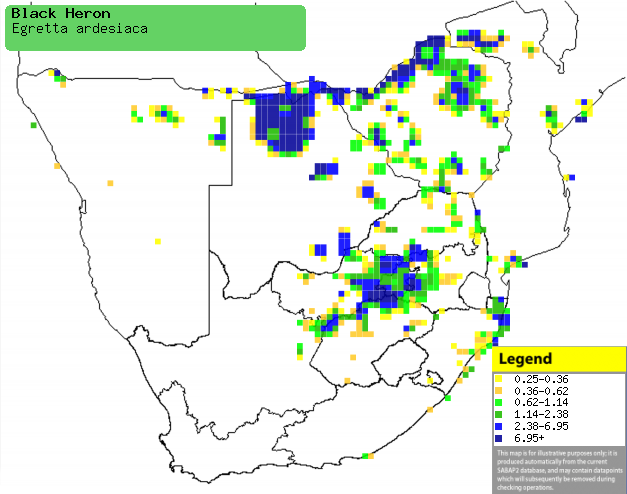|
Egretta ardesiaca (Black heron,
Black egret)
Swartreier [Afrikaans]; iKuwela [Zulu]; Samunkoma
gomusavagani [Kwangali]; Zwarte reiger [Dutch]; Aigrette ardoisée
[French]; Glockenreiher [German]; Garça-preta [Portuguese]
Life
> Eukaryotes >
Opisthokonta
> Metazoa (animals) >
Bilateria >
Deuterostomia > Chordata >
Craniata > Vertebrata (vertebrates) > Gnathostomata (jawed
vertebrates) > Teleostomi (teleost fish) > Osteichthyes (bony fish) > Class:
Sarcopterygii (lobe-finned
fish) > Stegocephalia (terrestrial
vertebrates) > Tetrapoda
(four-legged vertebrates) > Reptiliomorpha > Amniota >
Reptilia (reptiles) >
Romeriida > Diapsida > Archosauromorpha > Archosauria >
Dinosauria
(dinosaurs) > Saurischia > Theropoda (bipedal predatory dinosaurs) >
Coelurosauria > Maniraptora > Aves
(birds) > Order: Ciconiiformes
> Family: Ardeidae
Distribution and habitat
Occurs in isolated patches of sub-Saharan Africa; in
southern Africa, it is uncommon to locally common in central and southern
Mozambique, eastern and central South Africa (centred on Gauteng), Zimbabwe,
northern Botswana and the Caprivi Strip of Namibia. It generally favours shallow, permanent water bodies
such as marshes, rivers, lakes and dams, sometimes occupying seasonally flooded
grassland and estuaries.
|
 |
|
Distribution of Black heron in southern Africa,
based on statistical smoothing of the records from first SA Bird Atlas
Project (©
Animal Demography unit, University of
Cape Town; smoothing by Birgit Erni and Francesca Little). Colours range
from dark blue (most common) through to yellow (least common).
See here for the latest distribution
from the SABAP2. |
Movements and migrations
Little known, although it is most common in
southern Africa in summer.
Food
It mainly eats fish, supplemented with insects and
crustaceans, using a distinctive foraging technique in which it wades through
the water, intermittently forming a "canopy" for a few seconds (as in the photos
below) by touching its wingtips. The reason for doing this is still debated:
it could be to eliminate reflections, lure fish to a fake hiding place or
prevent prey from noticing any sudden movements. It uses this technique wherever
it feeds - captive birds often form the canopy over their plate of food!
Breeding
- Probably monogamous, breeding sporadically within a colony of other water
birds.
- The nest is a platform of sticks and twigs or reeds, grass leafy
branches, typically placed in a tree or reedbed, up to about six metres
above ground or water.
- Egg-laying season is from August-April, peaking from February-April in
South Africa and from August-January elsewhere in southern Africa.
- Very little is known about the eggs and chicks, other then that it lays
2-4 eggs.
Threats
Not threatened, although it is vulnerable to human
disturbance when breeding.
References
-
Hockey PAR, Dean WRJ and Ryan PG 2005. Roberts
- Birds of southern Africa, VIIth ed. The Trustees of the John Voelcker
Bird Book Fund, Cape Town.
|
